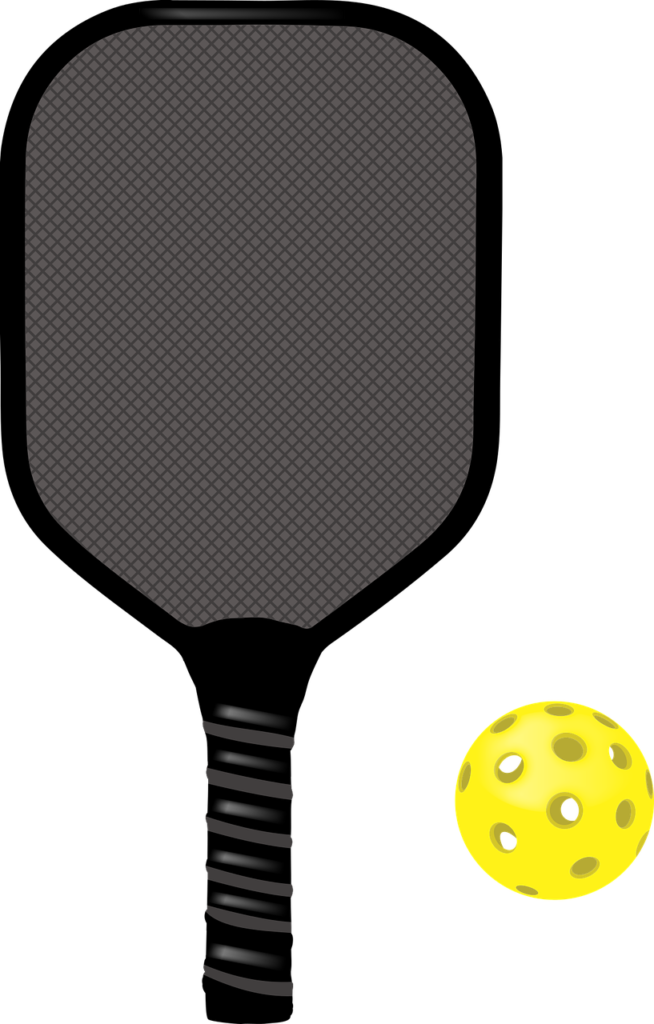Have you ever heard of pickleball? It’s a fun and fast-paced sport that combines elements of tennis, badminton, and ping pong. In this article, we’ll explore some interesting facts about pickleball that will leave you wanting to grab a paddle and join the game. From its origin story to the surprising health benefits it offers, there’s so much to discover about this increasingly popular sport. So, let’s get started and dive into the world of pickleball facts!
What is Pickleball?
Pickleball is a fun and exciting paddle sport that combines elements of tennis, badminton, and ping pong. It is played on a small court with a lowered net, using a paddle and a plastic ball with holes. The objective of the game is to hit the ball over the net, aiming to land it in the opponent’s court and score points. Pickleball can be played as a singles or doubles game, making it a versatile and inclusive sport for people of all ages and skill levels.
Origin of Pickleball
Pickleball was invented in 1965 by three friends – Joel Pritchard, Bill Bell, and Barney McCallum – on Bainbridge Island, Washington. The name “pickleball” is said to have originated from the Pritchards’ family dog, Pickles, who would chase after the ball and run off with it during the early days of the game. From its humble beginnings on a backyard court, pickleball quickly gained popularity and soon spread across the United States and beyond.
Rules of Pickleball
The rules of pickleball are simple and easy to learn, making it accessible to beginners. The game begins with a serve, which must be hit underhand and diagonally across the net. The ball must bounce once on the receiving side before players can hit it in the air. The ball always needs to be served to the diagonal square, and each team gets two serves per turn. The game is played till 11 or 15 points, and the winning team must have a two-point advantage.
Equipment Used in Pickleball
To play pickleball, you will need a few pieces of equipment. Firstly, you will need a pickleball paddle, which is a solid racket-like tool made of materials such as wood, composite, or graphite. The paddle is used to hit the ball over the net. Secondly, you will need a pickleball, which is a lightweight plastic ball with holes. Lastly, you will need a pickleball court, which is similar in size to a badminton court and has a lowered net. Comfortable clothing and court shoes are also recommended to enhance your performance and prevent injuries.
Popularity of Pickleball
Growth of Pickleball
Pickleball has experienced tremendous growth in recent years. What once started as a backyard game has now evolved into a rapidly growing global sport. The sport’s popularity can be attributed to its ease of play, inclusive nature, and the ability to adapt the game for players of all ages and abilities. From local community centers to professional tournaments, pickleball courts are popping up everywhere, catering to the growing demand and interest in the sport.
Demographics of Pickleball Players
Pickleball attracts players of all ages and backgrounds. It offers a social and recreational outlet for retirees seeking an active and engaging lifestyle. Additionally, younger players are also gravitating towards the sport, drawn to its fast-paced and competitive nature. Pickleball can be enjoyed by families, friends, and individuals alike, making it a great sport for fostering connections and building a sense of community.

Health Benefits of Pickleball
Physical Benefits
Engaging in regular pickleball play can have significant physical health benefits. The sport provides a full-body workout, combining cardiovascular exercise with muscle strengthening and flexibility training. The constant movement, quick reflexes, and agility required in pickleball contribute to improving endurance, coordination, balance, and overall physical fitness levels. Playing pickleball regularly can help reduce the risk of chronic diseases, such as heart disease, obesity, and diabetes, while also promoting weight loss and maintaining a healthy body composition.
Mental Benefits
Pickleball not only benefits physical health but also provides mental and emotional well-being. The game requires concentration, strategy, and quick decision-making, which can enhance cognitive function and mental agility. By stimulating the brain with various shots, tactics, and anticipation of opponents’ moves, pickleball can sharpen mental acuity and improve problem-solving skills. Moreover, the social aspect of the sport can boost mood, reduce stress levels, and foster a sense of belonging and camaraderie among players.
Pickleball vs Other Sports
Differences from Tennis
Although pickleball and tennis share similarities, there are several key differences between the two sports. Firstly, pickleball is played on a much smaller court, measuring 20 feet by 44 feet, compared to the larger tennis court. Additionally, pickleball has a lower net height, making it more accessible to beginners and players with limited mobility. The equipment used in pickleball, such as the paddle and ball, are also different from tennis. Pickleball is generally played as a doubles game, promoting teamwork and collaboration, while tennis can be played as both singles and doubles.
Differences from Badminton
Pickleball may draw some parallels to badminton due to their shared use of a net and racket-like equipment, but there are distinct differences between the two sports. Firstly, pickleball is played with a plastic ball, which is larger and heavier than the shuttlecock used in badminton. The court size and net height also differ, with pickleball courts being smaller and net heights lower. The rules of play, including the serve and ball bounce requirements, are also unique to each sport. Pickleball generally involves more short shots and close-range play compared to the longer rallies and shuttlecock manipulation seen in badminton.
Differences from Ping Pong
While pickleball and ping pong (table tennis) share a similar paddle and ball concept, they differ in terms of court size, net height, and gameplay. Pickleball is played on a court, allowing for more movement and physical engagement, whereas ping pong is played on a table, promoting quick reflexes and hand-eye coordination. The ball used in pickleball is larger and heavier, providing a different experience compared to the smaller and lighter ping pong ball. The rules and scoring systems also vary between the two sports, with pickleball emphasizing a mixture of power and finesse, while ping pong focuses more on speed and spin control.

Pickleball Tournaments and Competitions
Major Pickleball Tournaments
Pickleball enthusiasts have ample opportunities to showcase their skills and compete in various tournaments held worldwide. Some of the major pickleball tournaments include the US Open Pickleball Championships, the National Senior Games, the Tournament of Champions, and the Bainbridge Cup. These tournaments attract top players from around the world, offering spectators an exciting and competitive display of the sport. Whether you are a professional player or a passionate pickleball aficionado, participating in these tournaments can immerse you in the thrilling world of competitive pickleball.
Competitive Formats
Competitive pickleball can be played in various formats to accommodate different skill levels and preferences. The most common format is doubles, where teams of two players compete against each other. However, singles play, where individual players face off on the court, is also popular. There are different divisions within tournaments, such as age groups and skill levels, ensuring fair competition and providing opportunities for players of all abilities to participate. The competitive nature of pickleball tournaments adds an extra layer of excitement and challenge to the sport, pushing players to continuously improve their skills and strategy.
Tips for Beginners
Choosing the Right Paddle
As a beginner, selecting the right pickleball paddle is important to enhance your gameplay and comfort. Paddles come in a variety of materials, sizes, and weights, catering to different player preferences. Consider factors such as grip size, paddle weight, and surface texture when choosing a paddle. Experiment with different options to find a paddle that feels comfortable in your hand and allows you to generate power and control over your shots. Consulting with experienced players or seeking professional advice can also help guide you in making the right paddle selection.
Mastering the Serve
The serve is a fundamental aspect of pickleball and mastering it can give you a strategic advantage. Practice serving underhand, aiming for the diagonal service square on the other side of the net. Focus on hitting the ball with consistency and accuracy, placing it in areas that will make it difficult for your opponent to return. Experiment with different serving techniques, such as deep and short serves, to keep your opponents off balance. Developing a reliable and well-executed serve can set the tone for the entire game and give you a stronger position to win points.
Understanding Strategy
While pickleball is an enjoyable sport, understanding and employing proper strategy can greatly improve your chances of success. Develop a game plan based on your strengths and weaknesses, as well as the style of play of your opponents. Consider factors such as shot placement, court positioning, and communication with your partner in doubles play. Learning to anticipate your opponents’ moves and adjusting your strategy accordingly can help you gain an advantage on the court. Attend clinics, watch professional players, and practice regularly to develop a strategic mindset and elevate your pickleball skills.

Pickleball Clubs and Communities
Joining a Pickleball Club
Joining a pickleball club can be a fantastic way to engage with fellow enthusiasts, refine your skills, and immerse yourself in the pickleball community. Clubs provide a supportive and social environment for players of all levels, offering opportunities for friendly matches, organized tournaments, and skill-building sessions. Look for local pickleball clubs in your area, which can often be found at community centers, recreational facilities, or dedicated outdoor courts. By becoming a member of a club, you can enjoy regular play, receive coaching and guidance, and meet like-minded individuals who share your passion for pickleball.
Benefits of Pickleball Communities
Being part of a pickleball community offers numerous benefits beyond the game itself. It provides an avenue to socialize, make new friends, and build lasting relationships within a friendly and supportive environment. Connecting with fellow players allows for the exchange of tips, experiences, and camaraderie, fostering personal growth and a sense of belonging. Pickleball communities often organize social events, potlucks, and charity tournaments, bringing people together and contributing to the greater community. The shared passion and positive energy within these communities create a vibrant and welcoming atmosphere for all pickleball enthusiasts.
Famous Pickleball Players
Profiles of Top Players
The world of pickleball boasts a number of skilled and accomplished players who have made their mark on the sport. Some notable pickleball players include Simone Jardim, Tyson McGuffin, Ben Johns, and Lucy Kovalova. These players have consistently showcased exceptional skills, impressive shot-making abilities, and a deep understanding of the game. Their dedication, hard work, and passion for pickleball have placed them at the top of the pickleball rankings, earning them recognition and admiration within the pickleball community.
Achievements in Pickleball
In addition to their skill and talent, famous pickleball players have achieved notable accomplishments in the sport. They have won multiple national and international titles, set records, and contributed to the growth and development of pickleball at both the amateur and professional levels. Their achievements inspire aspiring players, motivate enthusiasts to push their limits, and contribute to the overall growth and popularity of pickleball as a competitive sport.
Pickleball Etiquette and Code of Conduct
Sportsmanship Guidelines
Pickleball, like any other sport, places great emphasis on sportsmanship and fair play. As a player, it is important to conduct yourself with respect, honesty, and integrity on and off the court. This involves displaying good sportsmanship, such as congratulating opponents on well-executed shots, refraining from unsportsmanlike behavior, and accepting outcomes graciously. Encouraging a positive atmosphere and maintaining a respectful attitude towards fellow players, officials, and spectators contribute to creating a pleasant and enjoyable pickleball experience for everyone involved.
Respecting Opponents and Officials
Respecting opponents and officials is an integral aspect of pickleball etiquette. Treat your opponents with respect, recognizing the effort they put into the game. Avoid any form of trash-talking, taunting, or unfair play that may diminish the enjoyment or fairness of the game. Additionally, it is important to show respect to officials and abide by their decisions, even if you disagree. Refrain from arguing or challenging their calls, as this can disrupt the flow of the game and create a negative environment. Cultivating a culture of respect and fairness enhances the pickleball experience for everyone involved.
Pickleball Strategy and Techniques
Dinking
Dinking is a strategic shot that involves hitting the ball softly and placing it close to the net, just over the net on your opponent’s side. The objective of dinking is to force your opponent into a difficult position by making it challenging for them to hit an offensive shot. Dinking requires control and precision, and is typically used when players are closer to the net. By employing dinking shots, you can disrupt your opponent’s rhythm and open up opportunities to take control of the game.
Third Shot Drop
The third shot drop is a crucial technique in pickleball, especially in doubles play. After the serve and return, it is the third shot that sets the stage for the rest of the point. The third shot drop involves hitting a soft, high-arching shot that lands in the opponent’s kitchen or close to the net. This shot allows you to regain control of the game, as it forces your opponents to hit the ball upwards and gives you time to move closer to the net. Mastering the third shot drop requires practice and finesse, as it can give you a strategic advantage and limit your opponents’ offensive options.
Stacking Formation
The stacking formation is a positional strategy used in doubles play to gain an advantage on the court. In a standard doubles formation, the partners stay on the same side of the court throughout the rally. However, in the stacking formation, one partner moves to the opposite side, creating a diagonal defensive position. This allows the partners to cover more of the court and put pressure on their opponents. The stacking strategy is often employed to counter strong shots or to take advantage of specific matchups. Proper communication and coordination with your partner are key to successfully implementing the stacking formation.
In conclusion, pickleball is a versatile and enjoyable sport that offers numerous benefits to players of all ages and skill levels. From its origins as a backyard game to its current popularity worldwide, pickleball continues to attract individuals, communities, and professional players. The game’s rules, equipment, and unique aspects set it apart from other sports, making it a distinctive and engaging experience. Whether you are a beginner or an experienced player, incorporating pickleball into your life can provide a holistic approach to fitness, mental well-being, and social connection. So grab a paddle, step onto the court, and experience the thrill of pickleball for yourself!

